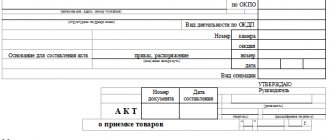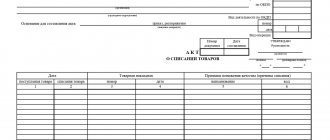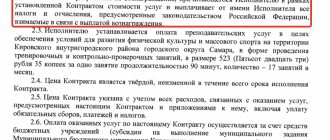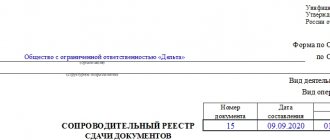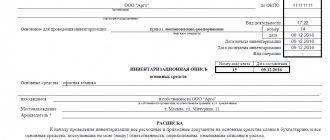The procedure for accepting imported goods
First of all, the procedure must be regulated by contract. The parties can agree that acceptance is carried out according to the rules in force in the buyer’s country, or define their own conditions, but then they must be described in detail in order to avoid misunderstandings and discrepancies.
If acceptance is only partially defined in the contract, then the rules defined by internal legislation are used in the unsettled part. In Russia, since October 15, 1990, the State Arbitration Instruction has been applied, the use of which constitutes a custom of trade turnover.
Goods must be accepted without interruption. Otherwise, the buyer is obliged to take measures to ensure the safety of the goods. Acceptance by quantity, carried out during the unloading of a wagon or container, occurs without interruption.
Act on the established discrepancy in quantity and quality when accepting imported goods Torg-3.
Unified form N TORG-3 Approved by Resolution of the State Statistics Committee of Russia dated December 25, 1998 N 132 Act on the established discrepancy in quantity and quality when accepting imported goods
(Form No. Torg-3) - used to formalize the acceptance of inventory items that have quantitative and qualitative discrepancies compared to the data in the supplier’s accompanying documents.
They are a legal basis for filing a claim with the supplier or sender. form form Torg-3 in Word and Excel format:
Acceptance of goods by the recipient in terms of quantity, quality and completeness of goods from transport organizations and postal items from communication organizations is formalized by an act in accordance with the rules in force in transport and communication organizations.
Acts on acceptance of goods by quantity are drawn up in accordance with the actual availability of goods, data contained in transport, accompanying or payment documents, and when accepting them by quality and completeness - the requirements for the quality of goods provided for in the agreement or contract.
Acts are drawn up based on the results of acceptance by members of the commission and an expert of the organization entrusted with conducting the examination, with the participation of representatives of the supplier and recipient organizations or a representative of the recipient organization with the participation of a competent representative of a disinterested organization.
Acts are drawn up separately for each supplier for each consignment of goods received under one transport document.
Commodity and material assets for which no discrepancies in quantity and quality have been established are not listed in the acts, about which a note is made at the end of the act with the following content: “There are no discrepancies for the remaining commodity and material assets.”
When accepting goods and material assets, acceptance certificates with attached documents (invoices, invoices, etc.) are transferred to the accounting department against receipt and for sending a letter of claim to the supplier or transport organization that delivered the goods.
An act in form N TORG-3 is drawn up for imported goods in five copies.
Download other forms on our website:
| Power of attorney for a car | Summary | Help 2-NDFL | Hotel form |
| Advance report JSC-1 | Invoice Torg-12 | Sales receipt | Invoice |
| Receipt cash order KO-1 | Travel certificate | Expense cash order KO-2 | Invoice |
Didn't find what you wanted - use the site map
Formation of the commission
Only a special commission can accept goods received during the execution of a foreign economic contract. It is not always created, but only in cases where there are discrepancies between the shipped and arrived goods.
The commission includes:
- buyer representatives;
- authorized person of the seller;
- expert of the examination bureau of the Chamber of Commerce and Industry or other disinterested organization.
The seller must be notified of the creation of a commission. After receiving the notification, he sends his representative. If this is not possible or the seller ignores the sent request, a representative of a third organization that is not interested in the result is invited to participate in the work of the commission. According to established custom, a representative of the Chamber of Commerce and Industry of the corresponding region is invited, since he meets the requirement of competence in matters of acceptance of goods. The commission is created immediately after the expiration of the period provided for the response. Since transport downtime is paid additionally.
The seller who has not sent his representative must give his consent to acceptance in the absence of an authorized representative. The tasks assigned to the commission include the responsibility for conducting expert research.
How to fill out the TORG-3 form
All information in the register must be indicated in accordance with the invoices and payment documents that accompany products from a foreign country. Information about quality, completeness and other requirements are prescribed in accordance with the terms of the contract.
TORG-3 consists of three pages. The first page is intended for general information - about the customer and supplier, the contract, accompanying documents. The second is for information about discrepancies, and the third is for the commission’s conclusion.
Instructions on how to draw up an act in form TORG-3 for the buyer:
- We fill in the organizational information: name of the customer and structural unit.
- We indicate the main codes: OKPO and type of activity.
- We write down the number and date of the act.
- We fill in the key information on the transaction: place and date of acceptance, details of the basis agreement, invoice numbers, names of the manufacturer, shipper, supplier and insurer, delivery method, veterinary certificate number, date of opening of the container.
- We determine the discrepancies in the table: on the left side we indicate the values according to the documents, on the right - the actual indicators.
- We draw up a conclusion. The final part is formed by the commission, signing the act in full.
- We approve TORG-3 with the manager.
Such an act is drawn up in 5 copies: one copy remains with the customer, the second is given to the supplier, the third is given to an independent expert or representative of the chamber of commerce (if he took part in the procedure), the fourth document is handed to an employee of the transport company. The fifth copy of TORG-3 is transferred to the accounting department, always against receipt. This form becomes the basis for transmitting a letter of claim to the supplier or transporter.
Example of filling out TORG-3:
Where is it used?
TORG-3 is necessary to compensate for damage caused to the buyer due to short delivery of goods or delivery of goods of inadequate quality. The procedure for compensation depends on the terms of the contract and the circumstances of the incident. Based on the report, a claim is subsequently drawn up. It can be sent to the seller or the forwarder, depending on who is to blame for the incident.
The submission of the act is accompanied by a letter of claim, to which additional documents are attached:
- papers of the seller or supplier, which indicate the quantity of goods, their completeness and other data;
- packaging labels attached to areas where defects were found;
- fillings;
- power of attorney of an authorized person;
- acts of sampling and analysis results;
- transport documents;
- other documents relevant to the case.
Where can I find the form and sample of filling out the act?
To record discrepancies when accepting imported goods, a separate form TORG-3 is provided, which should not be confused with either the outwardly very similar form TORG-2 (used for similar purposes for Russian goods), or with TORG-31 (similar in number, but having a completely different purpose).
Read more about the TORG-2 form in the material “Unified TORG-2 form - form and sample.”
You can always download the TORG-3 form on our website using the link below:
You can download an already completed sample document from ConsultantPlus by signing up for a trial demo access to know exactly what information should be entered in a particular column:
Filling rules
The act is drawn up in five copies. This differs from a similar form provided to reflect discrepancies in domestic deliveries (TORG-2). There is no need to seal all five acts.
The act compares the information included in the accompanying documentation with those reflected in the contract. Thus, to correctly fill out the following documents are needed:
- a contract, specification or other document indicating a list of goods, including their quantity and range and other necessary data, signed directly by the parties;
- accompanying documentation issued to the carrier and containing information about the completeness, quantity and name of the goods transferred for delivery;
- if there are no accompanying documents, then data from the packing lists and applied markings is recorded;
- the actual quantity is recorded when there are no documents indicated in paragraphs 2-3.
For each shipment received with one accompanying document and one seller, a separate act is drawn up. If discrepancies were not identified for all items of goods received, then data on completeness is not entered into the act, but at the end of the document it is necessarily noted that no discrepancies were identified for other (not reflected in the act) inventory items.
The carrier’s acts and documents are transferred to the organization’s accountant. Subsequently, the recipient has the right to send a claim to the seller based on the information identified.
When to use the TORG-3 act
If, upon acceptance of imported inventory items, a discrepancy was discovered in the quantity and quality of goods delivered from abroad, this fact must be documented using the TORG-3 form, so that compensation for damage can then be demanded.
In this case, a claim can be brought against either the supplier or the carrier, depending on whose fault the violation of contractual obligations was committed. When accepting inventory items, their actual quantity and condition are compared with those indicators that were reflected in the accompanying documents and the terms of the supply contract.
ConsultantPlus experts explained in detail what documents, in addition to TORG-3, need to be completed when returning goods to the supplier. To do everything correctly, get trial access to the system and go to the Ready solution. It's free.
When goods and materials are accepted from a carrier or postal service, an act in the TORG-3 form is drawn up according to the rules adopted by the transport organization.
IMPORTANT! Complete TORG-3 on the day the goods are accepted into the warehouse.
To find out whether it is possible to post goods received without accompanying documents, read the article “How to post goods without accompanying documents.”
Mistakes made when filling out the form
- The main mistake can be the wrong choice of form form. For internal turnover, almost the same form TORG-2 applies. It should not be confused with another form that has a similar name, 3-TORG PM. It is used to reflect information about the turnover of a small enterprise.
- Incomplete commission. The acceptance rules are determined by the agreement in whole or in part. If they are not there, then you should be guided by the customs of trade. An incomplete commission, the absence of documents confirming the impossibility of the appearance of a representative of the seller or TTP or another independent organization, casts doubt on the results of acceptance. In such a situation, the buyer may receive a refusal based on formal grounds for violating the acceptance procedure.
- Violation of the procedure for filling out the report: incorrect or incomplete description of product defects. This error can also lead to a failure.
- Lack of clear requirements from the buyer. When sending the act to the seller and accompanying it with a claim, you should indicate what actions he expects. Usually all situations are described in the contract. Otherwise, execution will not follow or it will be partially executed.
How to fill out a non-compliance report for imported goods
TORG-3 is drawn up in 5 identical copies, which is 1 copy more than when filling out a similar act, which is generated when the quality and quantity of domestically produced goods and materials do not correspond (we are talking about the TORG-2 form). In this case, there is no need to affix stamps on all 5 copies.
TORG-3 indicates the actual availability of goods and materials received from abroad - the relevant data is taken from the accompanying documents. But data on the planned completeness and quality of arriving goods and materials must be taken from the supply contract.
TORG-3 forms are compiled separately for each batch of goods and materials received under a single accompanying document, and for each supplier. If upon acceptance of a consignment of goods no discrepancies were identified for any of the items, then this item is not entered in the tabular part of the act, however, at the end of the document it should be indicated that no discrepancies were identified for other (not listed in the act) inventory items.
The executed acts, together with the accompanying documentation, are handed over to the accountant against signature. Next, the recipient of the goods and materials prepares a claim to the supplier (or carrier) based on the recorded facts.
TORG-3 consists of 3 pages. The 1st page reflects the available information about the supplier/buyer and the method of transportation. On the 2nd page information about the detected discrepancy is indicated, while data from shipping documents and actual data are entered.
The need to fill out the 3rd page of the act arises only when there is no need to conduct expert research. This is justified in situations where the discrepancy is due to underdelivery or incomplete delivery. If the delivery of low-quality products is discovered or the cargo was damaged during transportation, then an examination must be carried out, involving an independent organization.

